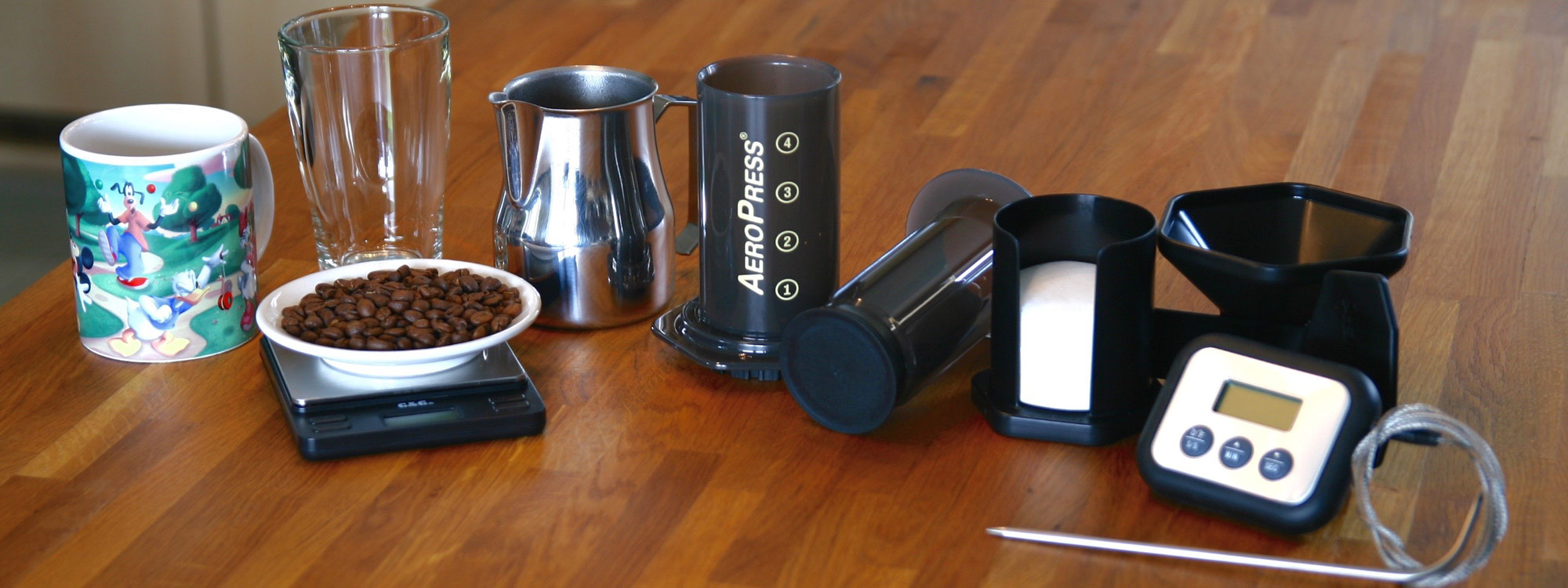The last few posts have mostly covered the older brewing methods. To balance that out a little, this post will cover the Aerobie AeroPress.
The AeroPress, a developing history
The AeroPress was designed by Aerobie inventor Alan Adler in 2005. Compared to the other brewing methods I’ve covered this is the simplest and most clearcut one yet in terms of history. Adler teaches mechanical engineering at the Stanford University. The AeroPress was the design Adler settled on after experimenting with various brew methods and variables.
Similar, but different
The way the AeroPress works makes it similar to a number of other brewing methods. For instance, it utilises a plunger much like the French Press. It also uses a fair bit of pressure, like an espresso machine. However, it is very different from a French Press or an espresso machine. A French Press doesn’t filter nearly as fine as an AeroPress. The AeroPress doesn’t use a compressed coffee puck and it doesn’t come remotely close to using 9 bars of pressure to force water through such a puck.
The way the AeroPress works is rather simple. In the brewing chamber you saturate and steep a certain amount of ground coffee and water. After a little bit of time you use the plunger to force the whole brew through the filter and into a cup. There are aftermarket metal filters available from a number of different manufacturers as well.
Things to gather
When you buy an AeroPress you basically have all you need, short of a few minor things.

Almost half of this comes supplied with the AeroPress
- AeroPress
- Hot water
- Freshly roasted coffee beans
- Grinder
- Scale
- Thermometer
- Sturdy cup
- Pitcher
Method 1: The traditional method
There are two ways to use the AeroPress, the traditional and the inverted method. I’ll be using the method that Shuichi Sasaki used to win the 2014 World AeroPress Championship.
- Grind 16.5 grams of beans medium fine, almost a Moka Press coarseness, slightly finer than French Press

What goes into the grinder isn’t half as important as what comes out of it
- Pre-heat the cup with a little bit of hot water and then empty it

A warm cup doesn’t instantly cool down your coffee
- Put a fresh filter into the filterholder and pre-wet it

Pre-wetting the filter gets rid of the paper taste
- Remove the plunger from the AeroPress

Make sure the AeroPress and its seal are perfectly clean!
- Screw the filterholder onto the base of the AeroPress

Twist to lock, don’t overdo it
- Put the Aeropress on top of the cup and the whole package on the scale

Choose a sturdy cup to prevent breaking it
- Drop the grounds into the Aeropress and tap it slightly to even them out

Use the funnel if you have to
- Slowly add 40 grams of 78C / ~172F water into the AeroPress

This is the blooming period in which the coffee has time to release the initial flavours
- Stir 5 times

Use the supplied stirring spoon or any other soft material spoon
- After 25 seconds, add another 210 grams of water

Add water to a total of 250 grams
- Stir once

Stir just once, don’t insert it all the way either
- Insert the plunger into the AeroPress and press down for a lengthy 75 seconds

For a 75 second press you don’t need a whole lot of pressure
- Don’t push down all the way, leave about 45 grams of brew in the AeroPress

Not pressing all the way through prevents certain bitter flavours to extract into your cup
- Remove the AeroPress from the cup

Place the AeroPress on a saucer or plate to keep it from leaking all over
- Enjoy!
Method 2: The inverted method
The one thing I noticed using the traditional method is that water starts seeping through the grounds and the filter into the cup fairly quickly. Especially when you’re using a coarser grind. For some recipes that’s a required part, for some it isn’t. The inverted method solves that “problem” by simply turning the AeroPress upside down. The method described here got Tibor Varaday to third place in the World AeroPress Championship of 2013.
- Grind 12 grams of beans medium coarse, similar to French Press

This one is slightly coarser than the previous recipe
- Insert the plunger into the AeroPress, remove the filterholder and put it upside down on the scale

The inverted method
- Drop the grounds into the AeroPress

Again, use the funnel if you have to
- Add 50 grams of 90C / 194F water

Add a little water to let the coffee bloom
- Stir 5 times, vigorously

No more stirring after this, make it count
- Add another 150 grams of water

Add water until you reach a 200 gram total (water only)
- Pre-wet a fresh paper filter in the filtercap and screw it onto the AeroPress

The wet filter sticks to the filterholder and doesn’t (generally) fall out
- Remove the air in the AeroPress by gently pressing down (still in the inverted position!) until you see water coming through the filter

Press down gently, air offers little to no resistance
- Put the Aeropress on the pitcher in the normal position and steep for 2 minutes, don’t press yet

Put the pitcher over the filterholder before turning the AeroPress right side up
- Press the plunger down firmly

Press with care, there’s hot water in there!
- Remove the AeroPress from the pitcher and serve

Don’t keep it in the pitcher too long, it will cool down quite fast
- Enjoy!
The beauty of the AeroPress is to be found in the many ways you can alter the taste of your brew. Because it uses a paper filter you can use all kinds of grindsettings, from very fine to very coarse. The time you leave the brew to steep has a vast influence on the taste of your brew as well. The amount of water used, the amount of coffee used down to how many times and how vigorously you stir, it all affects the taste of your coffee.
In a relatively short time this genuinely remarkable piece of equipment has grown to become a product many people love. In recent years there have even been championships! I personally love it for it’s portability, it’s great to take on vacations as you can throw it into your suitcase without having to worry about breaking it or those pesky weight limits.
The result
Personally I like both methods, but I like the second method best. I’ll be playing around with my AeroPress for a lot longer, trying different beans and other variables. I do very much encourage you to browse the World AeroPress Championship’s website for even more recipes. If you have a recipe you’d like to share I’d very much appreciate it if you left a comment below. If you like this post, I do appreciate you sharing it with your friends and family.
There are 7 more articles in the Brewing Methods series: The French Press, The Moka Pot, The Vacuum Coffee Maker, Turkish Coffee, Hario V60, Cold Brew Coffee and Espresso.



























Recent Comments